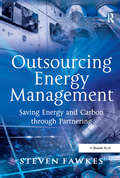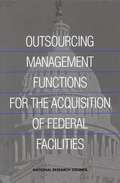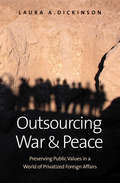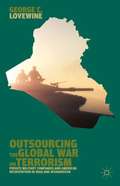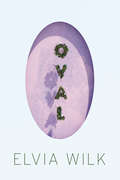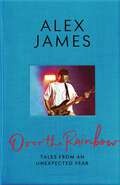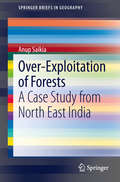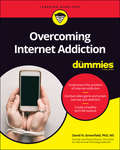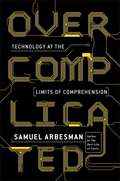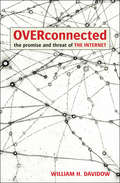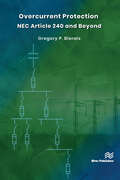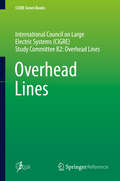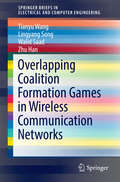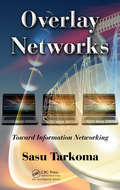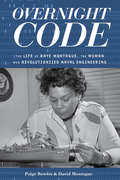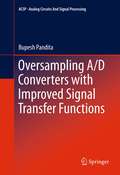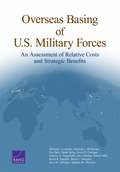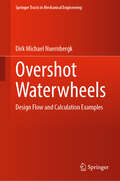- Table View
- List View
Outsourcing Energy Management: Saving Energy and Carbon through Partnering
by Steven FawkesThis book describes energy management outsourcing as a way of addressing the current energy challenges facing all organizations, namely high and volatile energy prices, the need to mitigate climate change and potential supply constraints as oil production peaks. These problems are likely to intensify in the coming years, yet most organizations have reduced in-house capability to address them, thus outsourcing is increasingly seen as an essential part of any strategy to reduce energy use and carbon emissions. The author describes the basic processes of energy management and how to outsource them in a strategic way to achieve maximum results. The process is based on a new model of energy management looking at total costs, which is presented in the book. The book offers a comprehensive guide to outsourcing energy management, discussing the risks and benefits and taking managers through the process of deciding whether to outsource or not, and finding and assessing an outsourcing partner. Managers looking to reduce energy consumption and carbon emissions through the use of external service providers will find Outsourcing Energy Management an ideal 'how to do it' guide.
Outsourcing Management Functions For The Acquisition Of Federal Facilities
by National Research CouncilA report on Outsourcing Management Functions For The Acquisition Of Federal Facilities
Outsourcing War and Peace
by Laura A. DickinsonOver the past decade, states and international organizations have shifted a surprising range of foreign policy functions to private contractors. But who is accountable when the employees of foreign private firms do violence or create harm? This timely book describes the services that are now delivered by private contractors and the threat this trend poses to core public values of human rights, democratic accountability, and transparency. The author offers a series of concrete reforms that are necessary to expand traditional legal accountability, construct better mechanisms of public participation, and alter the organizational structure and institutional culture of contractor firms. The result is a pragmatic, nuanced, and comprehensive set of responses to the problem of foreign affairs privatization.
Outsourcing the Global War on Terrorism
by George C. LovewineOutsourcing the Global War on Terrorism explores how the United States' war on terrorism, in both Iraq and Afghanistan, has required the US military to employ thousands of contracted civilians working for US and foreign Private Military and Private Security Companies (PMSCs). The actions and operations of unsupervised PMSCs has created an environment that had the potential to not only negatively influence tactical US objectives, but could also harm strategic local capacity-building initiatives. Given the military and political importance of US operations in Iraq and Afghanistan, George C. Lovewine provides a much-needed analysis of the interaction between commercial entities, military operations, and policy objectives. Lovewine's analyses identify the reactions and policy responses to these security issues faced by the United States military today.
Oval: A Novel
by Elvia WilkBizarre weather. Unprecedented economic disparity. Artists employed by corporations. And the ultimate work of art: Oval, a pill that increases generosity. This unforgettable debut novel asks questions of empathy and power on every scale—from bodies to bureaucracies—to create an unsettling portrait of the future. In the near future, Berlin’s real estate is being flipped in the name of “sustainability,” only to make the city even more unaffordable; artists are employed by corporations as consultants, and the weather is acting strange. When Anja and Louis are offered a rent-free home on an artificial mountain—yet another eco-friendly initiative run by a corporation—they seize the opportunity, but it isn’t long before the experimental house begins malfunctioning.After Louis’s mother dies, Anja is convinced he has changed. At work, Louis has become obsessed with a secret project: a pill called Oval that temporarily rewires the user’s brain to be more generous. While Anja is horrified, Louis believes he has found the solution to Berlin’s income inequality. Oval is a fascinating portrait of the unbalanced relationships that shape our world, as well as a prescient warning of what the future may hold.”A fascinating near-future exploration of relationships, sustainability, and power. An extraordinarily accomplished debut novel." —Jeff VanderMeer, author of Borne and Annihilation“Elvia Wilk’s Oval is a marvel. At the core of this seductive, acute, superbly-contemporary update of mid-period J.G. Ballard lies a deep-beating, deep-dreaming heart.” —Jonathan Lethem
Over and Out
by Jenni L. WalshPerfect for fans of Alan Gratz and Jennifer A. Nielsen, a gripping and accessible story of a young girl from Cold War East Berlin who is forced to spy for the secret police... but is determined to escape to freedom.Sophie has spent her entire life behind the Berlin Wall, guarded by land mines, towers, and attack dogs. A science lover, Sophie dreams of becoming an inventor... but that's unlikely in East Berlin, where the Stasi, the secret police, are always watching.Though she tries to avoid their notice, when her beloved neighbor is arrested, Sophie is called to her principal's office. There, a young Stasi officer asks Sophie if she'll spy on her neighbor after she is released. Sophie doesn't want to agree, but in reality has no choice: The Stasi threaten to bring her mother, who has a disability from post-polio syndrome, to an institution if Sophie does not comply.Sophie is backed into a corner, until she finds out, for the first time, that she has family on the other side of the Wall, in the West. This could be what she needs to attempt an escape with her mother to freedom -- if she can invent her way out.Jenni L. Walsh, author of I Am Defiance, tells a page-turning story of a young girl taking charge of her own destiny, and helping others do the same, in the face of oppression."Filled with adrenaline-inducing action and inspired by true stories, this novel evokes the perils of life in East Berlin and the risks some took in search of something better. The ingenuity Sophie and Katarina display in overcoming obstacles is compelling, and the no-win situation Sophie finds herself in rings painfully true. Page-turning action and dangerous intrigue fuel this Cold War-era novel." -- Kirkus Reviews
Over the Rainbow: Tales from an Unexpected Year
by Alex JamesA raucous, behind-the-scenes account of the year Blur got back togetherThere is nothing that can touch the sound made by a close-knit group of people who have been playing together for years and years and years, playing as though their lives depended on it. For many years, all our lives did, and actually, I’d suddenly realised, they did still.One winter’s night, Alex James received an unexpected call. Blur had been invited to play their biggest gig ever: Wembley Stadium. The only trouble was, he and his bandmates hadn’t spoken to – or even shouted at – each other for years. And he now had five children, an out-of-control menagerie of cats, and a sprawling farm to run.This is the story of what happened next. Taking us behind the scenes of a raucous, rollercoaster year, Alex describes how the band made a surprise – and emotional – return, recording an acclaimed album and playing sold-out shows around the world, from Colchester to Colombia and beyond. Plus: how he went on a crash diet to fit back into his ‘Britpop Trousers,’ somehow organised an entire festival of his own, and tried to perfect the recipe for a giant Frazzle. Over the Rainbow is a heartfelt and hilarious account of what it feels like to be catapulted back into the limelight with one of the world’s biggest bands. It is a love letter to Blur, to friendship and to music. And it shows us all that, however old – or hungover – we might feel, nothing’s ever truly over: it’s always just the start of the next thing.
Over-Exploitation of Forests
by Anup SaikiaNorth east India is a global biodiversity hotspot but a quite understudied area. Forest loss has always been problematic in the area. Using Landsat satellite data from three periods (70s, 80s/90s and 2010s), forest loss is assessed in sample protected areas and other sites in the study area, processing is undertaken using image processing and standard GIS tools. The landscape metrics of selected sites are assessed using the widely used program FRAGSTATS. Drivers of forest loss are central in the discussion of the study.
Overclocked: Stories of the Future Present
by Cory Doctorow"Cory Doctorow straps on his miner's helmet and takes you deep into the caverns and underground rivers of pop culture, here filtered through SF-colored glasses. Enjoy."--Neil Gaiman New York Times bestselling author Cory Doctorow has been hailed as one of the freshest voices in science fiction, and this collection of intriguing novellas is yet another reason why. Have you ever wondered what it's like to live through a bioweapon attack or to have every aspect of your life governed by invisible ants? In Cory Doctorow's collection of novellas, he wields his formidable experience in technology and computing to give us mind-bending sci-fi tales that explore the possibilities of information technology--and its various uses--run amok. "Anda's Game" is a spin on the bizarre new phenomenon of "cyber sweatshops," in which people are paid very low wages to play online games all day in order to generate in-game wealth, which can be converted into actual money. Another tale tells of the heroic exploits of "sysadmins"--systems administrators--as they defend the cyberworld, and hence the world at large, from worms and bioweapons. And yes, there's a story about zombies, too. "He sparkles! He fizzes! He does backflips and breaks the furniture! Science fiction needs Cory Doctorow." --Bruce Sterling, award-winning author of Schismatrix Plus and The Difference Engine
Overcoming Challenges in Online Learning: Perspectives from Asia and Africa (Routledge Research in Digital Education and Educational Technology)
by Areej ElSayary Abdulrasheed OlowoseluThis book examines four distinct areas of education that suffered as a result of the COVID-19 pandemic in Asian and African regions, and tackles the challenges and barriers that came as a result of the shift to online learning. Presenting perspectives from China, Malaysia, Nigeria, and the UAE, chapters frame research within the context of "innovation experiences" to explore transformative learning theory, and set out the ways in which leaders, educators, students, and parents adapted to learning during the pandemic. Foregrounding four central topics (challenges and barriers; teaching and learning; assessment; educational technology; and interactive learning environments), the volume provides globally relevant findings and implications for the effects of the pandemic on learning in these regions, and furthers the field of educational technology more broadly. Topics covered range from teaching and leading in the online learning environment to educational technology and the interactive learning space. Sharing innovative experiences to aid progression and share best practice for online learning moving forward, the book will be highly relevant to researchers, academics, and students in the fields of higher education, online and eLearning, and technology in education.
Overcoming Internet Addiction For Dummies
by David N. GreenfieldA guidebook to beating internet addiction and screen overuse and for living a fuller life There’s no escaping it―we live in a digital world. We work, play, socialize, and learn online, and the Internet provides many amazing opportunities. Unfortunately, because of our basic biology, we’re all susceptible to overuse and addiction to screens. Video games, social media, porn, and even scrolling online, taps into that pleasurable dopamine reward system. So, when is it time to log off or put the phone down and get help? Overcoming Internet Addiction For Dummies gives you the information, resources, and the self-assessment tools you need to discover how much is too much, along with practical suggestions on what to do about it. Learn how to take back control of your time and attention—or help your kids or loved ones get control of theirs. This comprehensive, user-friendly overview of Internet addiction is full of helpful and proven methods to help foster a healthy, balanced, and sustainable life with screens. Discover the basic biology of addiction, including why children and teens are especially susceptible. Become aware of the cognitive, psychological, and physical effects excess Internet and screen use. Learn how social media, video gaming, and Internet pornography could be getting in the way of real-time living. Find out why smartphones are not smart for you to use all the time. Understand the science of how and why you can become addicted to your screens so you can unplug more easily and use your time for what matters most. Empower yourself and your children to build a positive relationship with the Internet and digital technology. This book can help you and your loved ones plug back into life and show you where you can find information, resources, support, and treatment. Overcoming Internet Addiction is about taking back control of your time and attention and learning to manage your screen use, so it doesn’t manage you.
Overcomplicated: Technology at the Limits of Comprehension
by Samuel ArbesmanWhy did the New York Stock Exchange suspend trading without warning on July 8, 2015? Why did certain Toyota vehicles accelerate uncontrollably against the will of their drivers? Why does the programming inside our airplanes occasionally surprise its creators? After a thorough analysis by the top experts, the answers still elude us. You don't understand the software running your car or your iPhone. But here's a secret: neither do the geniuses at Apple or the Ph.D.'s at Toyota--not perfectly, anyway. No one, not lawyers, doctors, accountants, or policy makers, fully grasps the rules governing your tax return, your retirement account, or your hospital's medical machinery. The same technological advances that have simplified our lives have made the systems governing our lives incomprehensible, unpredictable, and overcomplicated. In Overcomplicated, complexity scientist Samuel Arbesman offers a fresh, insightful field guide to living with complex technologies that defy human comprehension. As technology grows more complex, Arbesman argues, its behavior mimics the vagaries of the natural world more than it conforms to a mathematical model. If we are to survive and thrive in this new age, we must abandon our need for governing principles and rules and accept the chaos. By embracing and observing the freak accidents and flukes that disrupt our lives, we can gain valuable clues about how our algorithms really work. What's more, we will become better thinkers, scientists, and innovators as a result. Lucid and energizing, this book is a vital new analysis of the world heralded as "modern" for anyone who wants to live wisely.
Overcomplicated: Technology at the Limits of Comprehension
by Samuel ArbesmanWhy did the New York Stock Exchange suspend trading without warning on July 8, 2015? Why did certain Toyota vehicles accelerate uncontrollably against the will of their drivers? Why does the programming inside our airplanes occasionally surprise its creators? After a thorough analysis by the top experts, the answers still elude us. You don’t understand the software running your car or your iPhone. But here’s a secret: neither do the geniuses at Apple or the Ph.D.’s at Toyota—not perfectly, anyway. No one, not lawyers, doctors, accountants, or policy makers, fully grasps the rules governing your tax return, your retirement account, or your hospital’s medical machinery. The same technological advances that have simplified our lives have made the systems governing our lives incomprehensible, unpredictable, and overcomplicated. In Overcomplicated, complexity scientist Samuel Arbesman offers a fresh, insightful field guide to living with complex technologies that defy human comprehension. As technology grows more complex, Arbesman argues, its behavior mimics the vagaries of the natural world more than it conforms to a mathematical model. If we are to survive and thrive in this new age, we must abandon our need for governing principles and rules and accept the chaos. By embracing and observing the freak accidents and flukes that disrupt our lives, we can gain valuable clues about how our algorithms really work. What’s more, we will become better thinkers, scientists, and innovators as a result. Lucid and energizing, this book is a vital new analysis of the world heralded as "modern" for anyone who wants to live wisely.
Overcomplicated: Technology at the Limits of Comprehension
by Samuel ArbesmanWhy did the New York Stock Exchange suspend trading without warning on July 8, 2015? Why did certain Toyota vehicles accelerate uncontrollably against the will of their drivers? Why does the programming inside our airplanes occasionally surprise its creators? After a thorough analysis by the top experts, the answers still elude us. You don't understand the software running your car or your iPhone. But here's a secret: neither do the geniuses at Apple or the Ph.D.'s at Toyota--not perfectly, anyway. No one, not lawyers, doctors, accountants, or policy makers, fully grasps the rules governing your tax return, your retirement account, or your hospital's medical machinery. The same technological advances that have simplified our lives have made the systems governing our lives incomprehensible, unpredictable, and overcomplicated. In Overcomplicated, complexity scientist Samuel Arbesman offers a fresh, insightful field guide to living with complex technologies that defy human comprehension. As technology grows more complex, Arbesman argues, its behavior mimics the vagaries of the natural world more than it conforms to a mathematical model. If we are to survive and thrive in this new age, we must abandon our need for governing principles and rules and accept the chaos. By embracing and observing the freak accidents and flukes that disrupt our lives, we can gain valuable clues about how our algorithms really work. What's more, we will become better thinkers, scientists, and innovators as a result. Lucid and energizing, this book is a vital new analysis of the world heralded as "modern" for anyone who wants to live wisely. From the Hardcover edition.
Overconnected: The Promise and Threat of the Internet
by William H. Davidow&“Shows how the unanticipated effects of the Internet are distorting economics, politics, international relations, and individual lives&” (James Fallows). In Overconnected, Bill Davidow, a former Silicon Valley executive, explains how the almost miraculous success of the Internet has also created a unique set of hazards, in effect overconnecting us, with the direst of consequences for our political, economic, and day-to-day lives. The practical applications—not least among them the ability to borrow money, invest in the stock market, or buy a new home—have made a great impact in our daily lives. But the luxuries of the connected age have taken on a momentum all of their own, ultimately becoming the root cause of a financial meltdown from which much of the world is now still struggling to recover. By meticulously and counter-intuitively anatomizing how being overconnected tends to create systems of positive feedback that have largely negative consequences, Davidow explains everything from the subprime-mortgage crisis to the meltdown of Iceland, from the loss of people&’s privacy to the spectacular fall of the stock market that forced the Federal Government to rescue institutions supposedly &“too big to fail.&” All because we were so miraculously wired together! Explaining how such symptoms of Internet connection as unforeseeable accidents and thought contagions acted to accelerate the downfall and make us permanently vulnerable to catastrophe, Davidow places our recent experience in historical perspective and offers a set of practical steps to minimize similar disasters in the future. Original, commonsensical and historically informed, Overconnected indentifies problems we live with that are now so large, omnipresent and part of our daily lives that few people have even noticed them.
Overcurrent Protection NEC Article 240 and Beyond
by Gregory P. BieralsAn overcurrent is caused by a short-circuit, ground-fault, or an overload. A short-circuit may be hundreds or even thousands of times above the normal operating current. This type of fault may be an arcing fault between ungrounded conductors or between an ungrounded conductor and a grounded (usually, a neutral) conductor, a line-to-line arcing fault may produce a current of 74% of a 3-phase bolted fault. A line-to-neutral arcing fault will be somewhat less. A line-to-line bolted fault, the equivalent, of the conductors bolted together, may be up to 100% of the available short-circuit current. A line-to-neutral bolted fault may be in excess of 100% of the 3-phase bolted fault at the source, but considerably less downstream. A ground-fault, that is, the equivalent of a connection between an ungrounded conductor and the equipment grounding system, will produce a current that may be 38% or higher of the 3-phase bolted fault current. These types of faults are typically arcing faults which normally are intermittent in nature. That is, they strike and restrike over time and may produce a short-circuit fault due to insulation damage. Once again, a line-to-equipment ground fault near the source may produce a fault current of over 100% of the 3-phase bolted fault, but considerably less downstream. An overload typically ranges from one to six times the normal current, and are normally caused by motor starting currents or transformer magnetizing currents. These conditions are of such short duration that the circuit components are not damaged. This book has a detailed analysis of these types of faults, along with explanations and examples of the various types of overcurrent protective devices to assure proper protection. This volume has extensive information on the application of overcurrent protection for conductors and equipment. The reader will be able to calculate fault currents as well as establishing the short-circuit withstand rating of conductor insulation and to determine the appropriate type of overcurrent devices based on circuit conditions. In addition, determining ground-fault currents for the purpose of selecting the proper size of equipment grounding conductors to establish an effective ground-fault current path is discussed in detail. Readership - Anyone involved with the design of overcurrent protection for electrical distribution systems from the system source to the electrical utilization equipment. The emphasis is placed on the design of the overcurrent protection for specific installations to assure proper protection for the circuit components regardless of the type of fault encountered.
Overhead Lines
by Konstantin O. PapailiouThis handbook offers all aspects of Overhead Transmission Lines as the backbone of networks of electrical power. The content of the book includes, after a historical flash-back: Planning and management concepts, electrical and mechanical considerations, influences of the weather, and on the environment, detailed design of all line components, construction and maintenance aspects, line optimization, and asset management, as well as a comparison between overhead lines and underground cables. The book was written by more than 50 experts and assembled through the Cigr#65533; study committee on Overhead Lines. This guarantees valuable exchange and dissemination of unbiased information for technical but also non-technical audiences.
Overlapping Coalition Formation Games in Wireless Communication Networks
by Zhu Han Walid Saad Tianyu Wang Lingyang SongThis brief introduces overlapping coalition formation games (OCF games), a novel mathematical framework from cooperative game theory that can be used to model, design and analyze cooperative scenarios in future wireless communication networks. The concepts of OCF games are explained, and several algorithmic aspects are studied. In addition, several major application scenarios are discussed. These applications are drawn from a variety of fields that include radio resource allocation in dense wireless networks, cooperative spectrum sensing for cognitive radio networks, and resource management for crowd sourcing. For each application, the use of OCF games is discussed in detail in order to show how this framework can be used to solve relevant wireless networking problems. Overlapping Coalition Formation Games in Wireless Communication Networks provides researchers, students and practitioners with a concise overview of existing works in this emerging area, exploring the relevant fundamental theories, key techniques, and significant applications.
Overlay Networks: Toward Information Networking.
by Sasu TarkomaWith their ability to solve problems in massive information distribution and processing, while keeping scaling costs low, overlay systems represent a rapidly growing area of R&D with important implications for the evolution of Internet architecture. Inspired by the author's articles on content based routing, Overlay Networks: Toward Information
Overnight Code: The Life of Raye Montague, the Woman Who Revolutionized Naval Engineering
by Paige Bowers David MontagueOvernight Code tells the story of Raye Montague, an ambitious little girl from segregated Little Rock who spent a lifetime educating herself, both inside and outside of the classroom, so that she could become the person and professional she aspired to be. Where some saw roadblocks, Montague only saw hurdles that needed to be overcome. Her mindset helped her become the first person to draft a Naval ship design by computer, using a program she worked late nights to debug. She did this as a single mother during the height of the Cold War, all the while imbuing her son with the hard-won wisdom she had accumulated throughout the years.Equal parts coming-of-age tale, civil rights history, and reflection on the power of education, Overnight Code is a tale about the persistence and perseverance required to forge the life of your dreams when the odds against you seem insurmountable, and shows how one woman refused to let other people's prejudices stand in the way of her success.
Overpowered
by Mark H. KrugerThe world's safest town might actually be a deadly kind of dangerous. And Nica Ashley is about to learn the hard way. Nica Ashley is accustomed to traveling the globe with her journalist mother, so when she gets sent to live in a small town with the father she barely knows, she's in for a bit of a culture shock. Barrington prides itself on being a sleepy, family community with the lowest crime rates in the state of Colorado. There's even a private security force run by Barrington Technology (BarTech) and a nightly curfew for all residents. On Nica's first day at school, she meets Jackson Winters and finds out he went from school superstar to living ghost after his girlfriend disappeared a few months ago. When Nica follows him out after curfew one night, they both witness a mysterious green flash--and the next morning the power has gone out and all the birds are dead. But secrets are well and alive, and as Nica and some of her friends discover they now have abilities best described as "super," they also realize that Barrington might not be so safe. And that BarTech is looking for them.
Oversampling A/D Converters with Improved Signal Transfer Functions
by Bupesh PanditaThis book describes techniques for designing complex, discrete-time ΔΣ ADCs with signal-transfer functions that significantly filter interfering signals. The book provides an understanding of theory, issues, and implementation of discrete complex ΔΣ ADCs. The concepts developed in each chapter are further explained by applying them to a target application of ΔΣ ADCs in DTV receivers.
Overseas Basing of U.S. Military Forces: An Assessment of Relative Costs and Strategic Benefits
by David R. Frelinger Michael J. Lostumbo John Halliday Eric Peltz Derek Eaton Stacie L. Pettyjohn Victoria A. Greenfield Jerry M. Sollinger Patrick Mills Bruce R. Nardulli Stephen M. Worman Michael J. McnerneyThis independent assessment is a comprehensive study of the strategic benefits, risks, and costs of U. S. military presence overseas. The report provides policymakers a way to evaluate the range of strategic benefits and costs that follow from revising the U. S. overseas military presence by characterizing how this presence contributes to assurance, deterrence, responsiveness, and security cooperation goals.
Overshot Waterwheels: Design Flow and Calculation Examples (Springer Tracts in Mechanical Engineering)
by Dirk Michael NuernbergkThis book on waterwheels deals with the calculation principles and design rules of overshot and backshot waterwheels. The overshot waterwheel is a hydropower machine and impresses with its simple construction, very good insensitivity to contamination, and the possibility of operation without a rake. In addition, this machine has a very good efficiency, which does not drop much even at partial load. Overshot water wheels are assumed to be used for electricity generation. The presentation therefore includes the calculation of the entire arrangement of the waterwheel - gearbox - and generator. Starting from the theoretical description, a design procedure is given, on the basis of which some example wheels are calculated. These example wheels have been in operation in Germany for several years. In addition, experimental results are given for the water wheels, which make the theory used verifiable. New developments are addressed, and illustrations and text have been updated in the translation of the 2nd German edition.
Overtaken
by Mark H. KrugerNica uses her powers of invisibility to face off against the evil corporation, Bar Tech, in this electrifying sequel to Overpowered.Nica Ashley can hardly recognize her own life anymore. Since moving to Barrington, she's discovered that her father is a secret government agent, she's fallen for the hot, brooding Jackson Winters, and oh yeah, there's the whole "I can become invisible" thing that happens whenever one of those strange green pulses light up the sky. But despite everything that's happened, nothing can prepare Nica for the sudden reappearance of Dana Fox, Jackson's girlfriend and the key to unraveling Bar Tech's sinister plot once and for all. Armed with just her invisibility and a lot of questions, Nica is determined to do just that...even if it means breaking curfew.?
